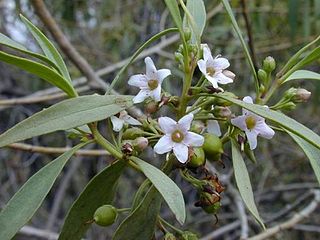
Myoporum is a genus of flowering plants in the figwort family, Scrophulariaceae. There are 30 species in the genus, eighteen of which are endemic to Australia although others are endemic to Pacific Islands, including New Zealand, and one is endemic to two Indian Ocean islands. They are shrubs or small trees with leaves that are arranged alternately and have white, occasionally pink flowers and a fruit that is a drupe.

Ganoderma orbiforme is a species of polypore fungus that is widespread across southeast Asia. It is a plant pathogen that causes basal stem rot, a disease of the African oil palm. The fungus was first described scientifically in 1838 by Elias Magnus Fries from collections made in Guinea. Leif Ryvarden transferred it to the genus Ganoderma in 2000. In addition to its type locality, the fungus has also been collected from the Bonin Islands in the Pacific, and from Venezuela and Puerto Rico. Microsatellite markers have been developed to help identify the fungus and study the genetic diversity of G. orbiforme.

Galium glaucum or waxy bedstraw is a plant species of the Rubiaceae. It is native to central Europe from Portugal to Ukraine, and sparingly naturalized in a few locations in North America.
Myoporum rapense is a plant in the figwort family, Scrophulariaceae and is endemic to French Polynesia and the Kermadec Islands. It is closely related to Myoporum laetum and there are two subspecies which are found on different island groups.
Myoporum rimatarense is a plant in the figwort family, Scrophulariaceae and is endemic to Rimatara Island in French Polynesia. It is only known from the type specimen collected in 1921 and 1934 and is presumed extinct.

Myoporum sandwicense, commonly known as naio, bastard sandalwood or false sandalwood is a species of flowering plant in the figwort family, Scrophulariaceae. It is a tree or shrub highly variable in its form, the size and shape of its leaves, in the number of flowers in a group and in the shape of its fruit. It is endemic to Hawaiʻi.
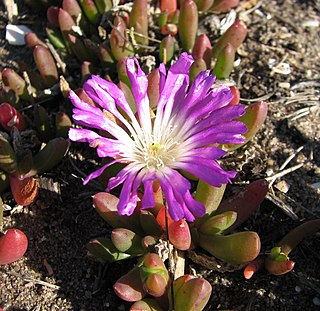
Disphyma is a genus of flowering plants in the family Aizoaceae that are native to New Zealand, Australia and southern Africa. Plants in this genus are prostrate, annual or short-lived perennial shrubs with succulent leaves and daisy-like flowers arranged singly on the ends of shoots with petal-like staminodes, many stamens and usually five styles.

Disphyma crassifolium subsp. clavellatum is the subspecies of Disphyma crassifolium that occurs in Australia and New Zealand. It is sometimes known by the common name rounded noon-flower
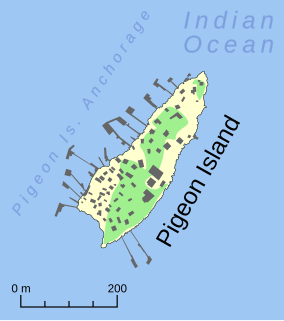
Pigeon Island is a small island located need the middle of the Wallabi Group of the Houtman Abrolhos, an archipelago off the coast of Western Australia. It is almost entirely given over to western rock lobster fishers' camps, and as a result is far more disturbed than most other islands in the archipelago. A nearby island also seasonally populated by fishers is named Little Pigeon Island, hence Pigeon Island is sometimes referred to as "Big Pigeon Island".
Apium prostratum subsp. howense is a flowering plant in the carrot family. The subspecific epithet refers to the island to which it is endemic.
Disphyma australe is a species of flowering plant in the family Aizoaceae and is endemic to New Zealand. It is a prostrate, succulent annual shrub or short-lived perennial plant with stems up to 2 m long, leaves that are three-sided in cross-section with a rounded lower angle, and white to deep pink daisy-like flowers with staminodes up to 30 mm (1.2 in) long.
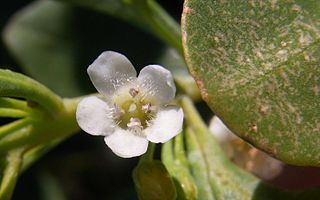
Myoporum boninense is a plant in the figwort family, Scrophulariaceae. It is a shrub with thick, fleshy, glossy leaves, white flowers in small groups and shiny lilac to pale purple fruits. It grows in coastal heath in New South Wales and Queensland in Australia and on islands in the north west Pacific Ocean.

Myoporum platycarpum, known by several common names including sugarwood, false sandalwood and ngural is a plant in the figwort family, Scrophulariaceae. It is rounded with bright green foliage as a young shrub and roughly fissured, dark grey bark when mature. Sugarwood is endemic to the southern half of continental Australia.
Conospermum filifolium is a shrub endemic to Western Australia.
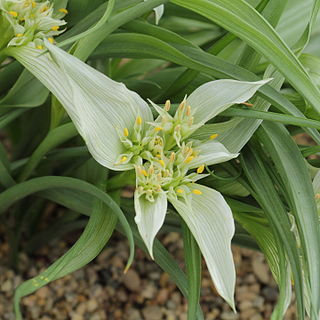
Androcymbium melanthioides is a plant native to Namibia and South Africa. It is not found in KwaZulu-Natal and is registered under the SANBI Red List as "safe" (LC).









